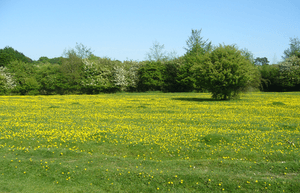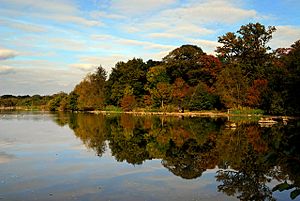Hatfield Forest facts for kids
| Site of Special Scientific Interest | |
 |
|
| Area of Search | Essex |
|---|---|
| Interest | Biological |
| Area | 403.2 hectares |
| Notification | 1985 |
| Location map | Magic Map |
Hatfield Forest is a very special natural area in Essex, England. It's about three miles east of Bishop's Stortford. This huge forest covers 403.2 hectares, which is like 1,000 football fields! It's so important that it's known as a Site of Special Scientific Interest and a National Nature Reserve.
The forest is owned and looked after by the National Trust. A very old rabbit warren inside the forest is also a Scheduled Monument, meaning it's protected for its historical value.
Hatfield Forest is unique because it's the only complete "Royal Hunting Forest" left from the time of the Norman kings. These forests were created for kings and lords to hunt deer. The word 'forest' back then meant a place for deer, not just a place with lots of trees. Hatfield Forest has both woodlands and open plains.
Oliver Rackham, a famous expert on the countryside, wrote a book about Hatfield Forest. He said that it's incredibly important because it still has all the parts of a medieval forest. This includes deer, cattle, special types of woods, grasslands, and even marshy areas. He believed it's probably one-of-a-kind in England, and maybe even the world! He also said that visiting Hatfield Forest is like stepping back into the Middle Ages.
Contents
History of Hatfield Forest
There isn't an exact date for when Hatfield became a Royal Forest. Records suggest it was sometime between the years 1086 and 1225.
From Kings to Families
In 1238, King Henry III gave the land and trees to Isobel of Huntingdon. However, the king kept the right to hunt deer there. Isobel married into the Bruce family. The forest stayed with them until 1306. That's when Robert the Bruce had his English lands taken by King Edward I.
After King Edward I died, King Edward II gave the forest to the de Bohun family. The king still owned the right to the deer meat (called venison). But the de Bohuns owned the wood and soil. In 1446, the de Bohun family was also given the right to the deer. This happened shortly after they became the Dukes of Buckingham.
However, in 1521, the third Duke, Edward Stafford, 3rd Duke of Buckingham, was executed by King Henry VIII. Because of this, the forest went back to the Crown. After Henry's death, Edward VI gave the forest to Sir Richard Rich.
Changes Over Centuries
In 1592, the Rich family sold their part of the forest to Baron Morley. In 1612, they sold the rest of their Hatfield estate to Sir Francis Barrington. This led to many arguments over who owned the forest for the next 200 years.
In 1729, the wealthy Houblon family bought the forest. They were originally from Lille. One famous family member was John Houblon, the first Governor of the Bank of England. The Houblons kept the traditional ways of managing the woodland. They also probably got help from a famous landscape designer called Capability Brown.
Because of this, a beautiful lake was created in the forest. They also planted trees that were not native to Essex. A small building called the Shell House was built overlooking the lake. In 1759, 17-year-old Laetitia Houblon decorated it with British and tropical shells. You can still visit this Shell House today!
The forest stayed with the Houblon family until 1923. Then, Edward North Buxton bought the forest and gave it to the National Trust.
Plane Crash in 1999
On December 22, 1999, Korean Air Cargo Flight 8509 crashed into the forest. This happened after it took off from London Stansted Airport. The plane, a Boeing 747-200F, just missed hitting houses nearby. All four crew members on board died when it crashed.
Woodland Management
Hatfield Forest was a woodland long before it became a royal forest. People have managed it using two main methods: coppicing and pollarding.
Coppicing and Pollarding
- Coppicing: This is when trees are cut down close to the ground. New shoots then grow from the stump. These new shoots need to be protected from animals eating them. So, fences, ditches, and banks are used.
- Pollarding: This is when trees are cut higher up, above the height where deer or cattle can eat the new growth.
The wood cut from these methods was used for many things. This included firewood, fences, roof thatch, furniture, and even flood defenses. These methods have stayed the same for hundreds of years. Some trees were left to grow tall instead of being cut. These "standards" were used for timber in buildings and ships. You can still see these traditional woodland management methods in the forest today.
Archaeology in the Forest
Hatfield Forest has never been ploughed. This means many old archaeological remains are still there. The most important ones are Portingbury Rings and the warren area.
Portingbury Rings
At Portingbury Rings, people have found things from the Iron Age. These include a small flint blade, pieces of pottery, animal bones, burnt flint, and charcoal. The earthworks (mounds and ditches) at Portingbury might date back to the Iron Age. However, the ditches are also similar in size to medieval moats. The earthworks you see today might be layers built up over time.
The Warren and Other Remains
The Warren was made for rabbits. It was built in an area that already had mounds. Warren Cottage was built for the person who looked after the rabbits (the warrener). Forest Lodge was built for the head woodsman.
Later remains include Victorian fence columns. These were put up around 1857 when the forest was fenced in. Some columns are still there today. Sections of the old fencing have been rebuilt near the Shell House car park and in Gravel Pit Coppice.
Parts of the forest were also used during World War II. They hid military supplies for the airfield at Stansted. You can still see the remains of the huts built at that time along the entry and exit roads.
Ecological Importance
The natural environment of Hatfield Forest is in excellent condition. It is one of the largest areas in East Anglia that has never been ploughed. This means it has a wide variety of natural homes, called habitats. These include coppice woodland, wood pasture, scrub, grassy plains, marsh, and a lake.
These ancient woodlands and pastures are very rare today. They are like living pieces of the original British wildwood. They provide a last safe place for many unusual and special animals and plants.
Wildlife of Hatfield Forest
Because Hatfield Forest has so many unspoiled habitats, it's home to a lot of wildlife. You can find many different kinds of plants and animals here.
Mammals
Some of the mammals you might see in the forest include fallow deer and muntjac deer. You might also spot a fox, grey squirrel, rabbit, weasel, and hedgehog. There are also badger homes, called setts. However, badgers are mostly active at night, so they are rarely seen.
Two herds of Red Poll cattle graze the plains in the traditional way. Sheep are also used to help keep certain areas clear of scrub. The types of sheep used are Speckled Faced Beulah, Wiltshire Horn, and Manx Loaghtan.
Birds
In May 2008, a count found 58 different kinds of birds in the forest. They are attracted by the different habitats.
- Woodland Birds: These include the jay, green woodpecker, great spotted woodpecker, carrion crow, blue tit, great tit, chaffinch, nightingale, kestrel, and bullfinch.
- Around the Lake: Depending on the time of year, you might see greylag geese, Canada geese, mute swan, great crested grebe, common tern, moorhen, coot, and sometimes a kingfisher. You might also spot a cormorant and a grey heron. Swallows and house martins can be seen flying low over the water.
- Birds of Prey: Buzzards are also being seen more and more often flying above the forest.
Bats
Eight different kinds of bats live in the forest. The best time to see them is at dusk, as the sun sets.
Invertebrates
Hatfield Forest is especially important for its invertebrates. These are small creatures without backbones, like insects. It's particularly important for beetles that live in decaying wood. The forest is one of the top 10 places in the UK for these special beetles.
Plants and Trees
The forest has many different kinds of trees. The main ones are oak, ash, hornbeam, hawthorn, hazel, and field maple. There are over 800 very old trees in the wood pasture areas. Some of these trees are more than 1,200 years old! The huge pollarded oaks and hornbeams are especially impressive.
Mistletoe grows very well here, especially on the old hawthorn bushes. The most famous tree in the forest was the Doodle Oak. It was one of the largest trees ever to grow in England. It last had green leaves in 1858. Its location is marked in the northern part of the forest.
More than 400 species of plants have been found in the forest. Some common ones include white clover, common spotted orchid, selfheal, sheep's sorrel, herb robert, bugle, agrimony, bee orchid, perforate St John's wort, common field speedwell, and bird's foot trefoil. In late May and early June, large areas of the forest are covered in buttercups. Over 600 species of fungi can also be found here.
Visitor Facilities
Hatfield Forest has many miles of walking paths. It is open to people on foot at all times. There is a car park at the entrance that is always open.
Two boardwalks make it easier for visitors to get around, especially those with strollers. One boardwalk goes to the Lake and the facilities in the Lake Area. The other is a sensory trail. This trail helps people who are visually impaired to enjoy the forest.
You can also go horse riding and fishing in the forest. However, you need to get a permit first.



